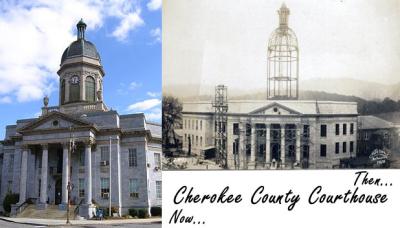Murphy, North Carolina, is the county seat of Cherokee County – located in the heart of the Appalachian Mountains. Murphy is an old town with its origins dating back to the 1830s.
Downtown is beautiful with flower lined streets and several historic buildings. Murphy has restaurants, unique shops, and other interesting establishments all within walking distance in the heart of town.
Recreational activities are unlimited from local trout streams to mountain biking. Hiwassee Lake is considered one of the most beautiful in the state. Murphy offers something for every sports enthusiast. If you are looking for a beautiful small town in the mountains, look no further. Murphy, with its population of 1700, resembles a Norman Rockwell painting. It is indeed small town life at the very best. We look forward to seeing you!

History
The site of Murphy, along the Hiwassee River, was known to the Cherokee as Tlanusi-yi (the Leech Place), because of a legend about a giant leech named Tlanusi that lived in the river here. The Trading Path (later called the "Unicoi Turnpike") passed by the future site of Murphy, connecting the Cherokee lands east of the mountains with the "Overhill Towns" of Tennessee.
The town was first called by the name of "Huntington" in the 1820s through the 1830s, when the first post office operated by Col. Archibald Russell Spence Hunter was established. He was also the first white settler to build a frame house in the Cherokee Territory, later Cherokee County.
In 1836, during the Cherokee removal known as the Trail of Tears, the United States army built Fort Butler in what is today Murphy. Fort Butler acted as the main collection point for Cherokee east of the mountains. From Fort Butler the Cherokee were taken over the mountains on the Unicoi Turnpike to the main internment camps at Fort Cass (today Charleston, Tennessee). Today the Unicoi Turnpike is known as the Joe Brown Highway. Fort Butler is no longer a structure, but the site can be visited with historical markers to read. The Cherokee County Historical Museum located in downtown Murphy provides information about the Trail of Tears.
Cherokee County was formed in 1839 from a portion of Macon County, but Murphy wasn't incorporated as the county seat until 1851.
Murphy was once the terminus of the two train lines. The Mineral Bluff, GA spur line (L&N Railroad) came out of North GA and the Murphy Branch (Southern Railroad) came from Asheville. The L&N line was removed in the mid 1980s. The tracks for the Murphy Branch remain but are inoperable. It has been idle since the mid 1990s when the Great Smoky Mountain Railroad discontinued service between Murphy and Andrews. The L&N Depot remains as a community center just southwest of downtown Murphy. Murphy was the home of the once well-known crafts manufacturer Margaret Studios, which operated a nationwide chain of gift stores for its woodcraft products and housewares, such as lazy Susans and gift trays.
Folklorist John Jacob Niles based his well-known Christmas song "I Wonder as I Wander" on a phrase he heard in a song sung by the young daughter of a group of traveling evangelists in downtown Murphy on July 16, 1933.
Architect James Baldwin designed the Cherokee County Courthouse, located in downtown Murphy, in a Beaux-Arts style. Built in 1927, it is faced with locally sourced blue marble and is listed in the National Register of Historic Places along with the Robert Lafayette Cooper House and Harshaw Chapel and Cemetery.
Geography
Murphy is located east of the center of Cherokee County at 35°5′23″N 84°1′48″W (35.089848, −84.029924).
According to the United States Census Bureau, the town has a total area of 2.6 square miles (6.8 km2), of which 2.4 square miles (6.2 km2) is land and 0.23 square miles (0.6 km2), or 9.13%, is water.
The town is located at the confluence of the Hiwassee and Valley Rivers.
Topography
Murphy is located in southwestern North Carolina, approximately halfway between Atlanta, Georgia and Knoxville, Tennessee. The location in the Blue Ridge Mountains has helped the community retain a fairly rural character, surrounded by wildlife such as bear, deer, fox and recently reintroduced elk.
Climate
Murphy has a humid subtropical climate, (Cfa) according to the Köppen classification, with hot, humid summers and cool to mild winters. Murphy has temperatures significantly cooler than other parts of the Southeast, due in part to elevation. Like the rest of the southeastern U.S., Murphy receives abundant rainfall, greatest in winter and enhanced by the elevation. Receiving as much as 100 inches per year in some parts, areas of Cherokee County are considered part of the Appalachian temperate rainforest. Blizzards are rare but possible; the 1993 Storm of the Century dropped 15 inches (38 cm) in 24 hours with more snowfall dropping up to 38" in some areas – causing widespread power outages and disruption.
Information derived from WikiPedia
